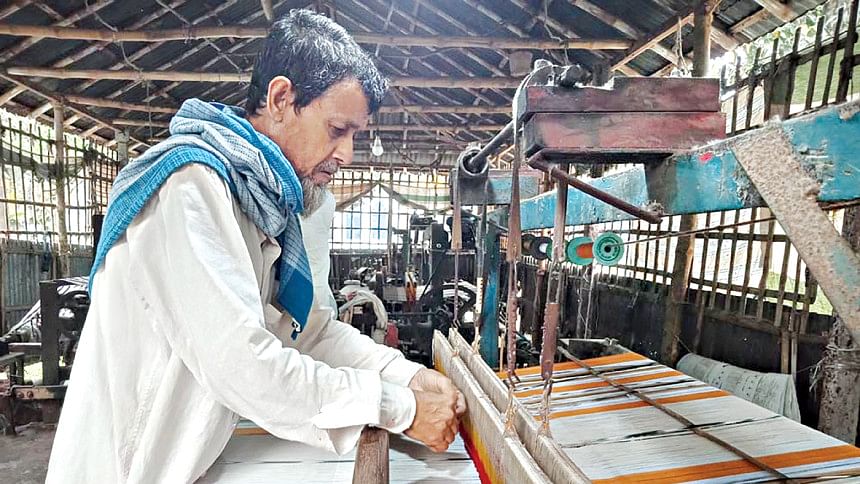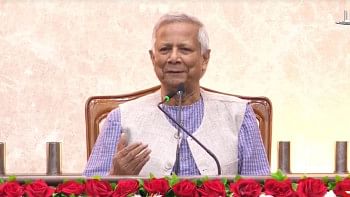Weavers in a bind as costs soar, Eid sales slump

With Eid-ul-Fitr just a week away, weavers in Pabna and Sirajganj, the country's major handloom cloth-producing regions, are frustrated by soaring production costs and poor sales.
Weavers say sales for Zakat clothes and supply to India have faltered this year, while yarn prices have increased by 50 percent. In response, cloth prices have risen by only 10 percent, leaving them with minimal profits.
According to the Handloom and Power Loom Owners Association, only 250,000 of the 450,000 looms in Pabna and Sirajganj are operational this year.
Though these looms manufacture mainly sari, lungi and gamcha year-round, Eid sales are the lifeblood of the business.
"Due to excessive production costs, small and marginal weavers in Pabna and Sirajganj are unable to run their factories," said Md Hydar Ali, director of the Bangladesh Specialised Textile Mills and Powerloom Industries Association.
For example, Md Uzzal Bishwas, a weaver from Kulunia village, closed his factory several months ago and is now working as a labourer to make his ends meet.
"I had five looms, but the factory closed last year. Ahead of the Eid festival, my brothers and I have been working in my factory as labourers, while another company invested yarn and colours for cloth manufacturing."
He said it was better to work as a labourer than remain jobless. "We are earning Tk 250 to Tk 300 producing 8 to 10 lungis a day, which helps with family expenses."
Like them, most small and marginal weavers are facing similar difficulties with rising yarn prices and shrinking profits.
"Each bundle of yarn previously was sold for Tk 26,000 to Tk 28,000. Now, we bought each bundle for Tk 30,000 for making Eid clothes last month," said Md Abdus Sattar, a power loom factory owner from Dogasi Kulunia village in Pabna Sadar upazila.
He added that while yarn prices had risen sharply, cloth prices had not kept pace.
"Last year, we sold each lungi for Tk 300 to Tk 320, making a profit of Tk 30 to 40 per piece. This year, each lungi sells for Tk 340 to Tk 350, with a profit of only Tk 10 to 15 per piece."
"This is not enough to survive," said Sattar, adding that five of his 10 power looms remained closed due to poor profits.
Handloom and power loom factories in Pabna and Sirajganj use 80-count yarn, which local spinning mills do not produce due to high manufacturing costs. This yarn is mostly imported from India and China.
Md Shakil Ahmed, a spinning trader of Dhaka, said the price of 80-count yarn has increased as Indian yarn is hardly coming since last year. This is being attributed to increased yarn prices this year.
Powerloom Industries Association Director Hydar Ali said that although small and marginal weavers' associations across the country are eligible for duty-free yarn support from the government, they have received little support over the years.
Weavers also said that the availability of cheap Indian yarn, which helped last year, has decreased, forcing them to buy yarn at inflated prices.
SALES NOSEDIVE
Traders claimed handloom cloth sales are significantly lower than last year's festival sales.
"Last year, I used to sell around 400 to 500 thaan (each thaan means four lungis) on each market day, with at least 1,500 to 1,600 thaan sold weekly ahead of Eid-ul-Fitr. But this year, I am selling only 250 to 300 thaan lungis on each market day," Md Golam Hossain, a wholesale trader of handloom cloth at Shahzadpur market, told The Daily Star.
"This is very poor sales in the festival market," Hossain added.
He added that fewer buyers from different districts and abroad are coming to Shahzadpur wholesale market, the country's largest handloom cloth wholesale market, contributing to the decreased sales.
Bodiuzzaman, a leading trader at Shahzadpur wholesale market, told The Daily Star, "Handloom cloth worth Tk 150 crore to Tk 200 crore used to sell from Shahzadpur wholesale market ahead of Eid last year, but this year we are barely getting Tk 100 crore in sales."
"Many people used to buy sari and lungi for Zakat during Eid-ul-Fitr every year, but this year there are hardly any Zakat sales, as wealthy individuals are trying to remain inconspicuous," said Bodiuzzaman.
According to the Handloom and Power Loom Owners Association, only 250,000 of the 450,000 looms in Pabna and Sirajganj are operational this year
"Besides, supplying cloths to India from Shahzadpur haat has stopped this year, which has decreased cloth sales," he added.
He claimed that a large number of handloom cloths, including sari, lungi, and gamcha, used to be supplied to India through the Benapole border, but traders from India are barely coming this year.
"Weavers are dependent on local buyers, so festival business has been badly hampered this year," he added.

 For all latest news, follow The Daily Star's Google News channel.
For all latest news, follow The Daily Star's Google News channel. 



Comments